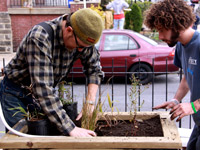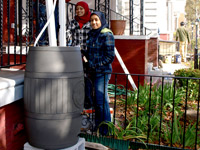 story by Jacob LambertIn Philadelphia, there is nothing as cleansing as a good rain. In the moments after a storm, the city feels renewed: trees drip, skies clear and birds reemerge. Dirt, soot and trash have been swiftly swept away. The concrete and pavement feel, if not exactly new, at least a little fresher. Unfortunately, this temporary idyll masks an unseen crisis: washing the city clean incurs a steep environmental cost.
story by Jacob LambertIn Philadelphia, there is nothing as cleansing as a good rain. In the moments after a storm, the city feels renewed: trees drip, skies clear and birds reemerge. Dirt, soot and trash have been swiftly swept away. The concrete and pavement feel, if not exactly new, at least a little fresher. Unfortunately, this temporary idyll masks an unseen crisis: washing the city clean incurs a steep environmental cost.
Two-thirds of Philadelphia—from East Germantown to South Philadelphia and most parts in between—sits above a Combined Sewer System, in which precipitation and wastewater run into a single pipe. (The remainder uses a Separate System, keeping the liquids apart.) In dry times, combined sewers do not pose a problem: Emptied tubs and toilet flushes flow to one of three treatment plants across the city. But, when it rains, water cascades off roofs and lots into dirty streets, picking up pollutants before dropping into inlets and mixing with civic waste.
“That’s the way these systems were designed; that’s the way our city was designed,” says Howard Neukrug, director of the Philadelphia Water Department’s (PWD) Office of Watersheds. Older cities such as Philadelphia, Cleveland and Washington, D.C. cope with the fact that during heavy rain, this outdated design causes overflow into rivers and streams. “Our system was not built to hold back all the rainfall,” adds Neukrug.
In 164 spots along five waterways—the Delaware and Schuylkill Rivers, as well as the Cobbs, Tacony-Frankford, and lower Pennypack Creeks—Combined Sewer Outfalls (CSOs) act as discharge valves. On sunny days, these outfall pipes have nothing to expel. But during storms, they siphon the city’s murky soup straight into the water, rendering freshwater bodies decidedly less fresh. “Stormwater significantly affects water quality, since it carries contaminants from impervious surfaces and lawns into streams and rivers,” reads a Water Department document. “Though there is more water in the streams and rivers during storms, there are more contaminants as well. As stream flow increases… bacteria levels and turbidity rise dramatically.”

Other consequences include erosion, flooding and loss of habitat. “Our rivers and streams have come a long way,” says Joanne Dahme, PWD’s general manager of public affairs. “But now, for the remaining incremental improvements, we need to get a better handle on how we deal with stormwater.”
This need has long been recognized. In 1997, to comply with an Environmental Protection Agency-mandated 85 percent decrease in CSO outflow, the department submitted a long-term plan proposing myriad improvements, with special attention given to area watersheds. “The development of these plans further clarified our need to come up with a greener, more holistic strategy,” says Dahme. In 2007, that strategy emerged as the “Green City, Clean Waters” program. At a September event in Washington, D.C., Mayor Michael Nutter called the new approach “bold and game-changing.”
That description was not mere political hyperbole. The size and intractability of Philadelphia’s current problem—after all, half of the city can’t replace its pipes—demands an equal response. Neukrug’s office, along with the EPA and Pennsylvania’s Department of Environmental Protection, has willingly shouldered the burden. “[Cities have] spent the last 50 to 75 years trying to prevent all that overflow into our rivers and streams,” says Neukrug, who holds degrees in Civil and Urban Engineering from the University of Pennsylvania. “We started to do that by building more and more infrastructure over our old infrastructure”—akin to unclogging an artery by grafting a new one around it. In Neukrug’s view, such remedies are impractical; fresh tactics must be devised. “We’re at a crossroads,” he says.
A conventional fix would entail, in Neukrug’s words, “an $8 billion sewer so big that we’d call it a tunnel, running for miles up and down the Schuylkill and Delaware Rivers.” Conversely, Green City, Clean Waters aims to keep water out of inlets in the first place. In his September address, Nutter described a city in which “[infrastructure] will keep stormwater out of our system by recreating the natural systems that centuries of urbanization have degraded.”
Under the program’s “Green Homes” arm, houses will sprout green roofs and rain gardens. Downspouts will run into barrels; grassy sidewalk bump-outs and specially-designed tree pits will also capture water. With “Green Streets,” roads will be paved with permeable surfaces; idle lots will be transformed into pocket parks and gardens. Other lots will be pitched towards “bioswales”—lushly absorbent spaces along their outer edges. If the 25-year plan succeeds as envisioned, Philadelphia will become a very different place.

“For folks at the Water Department, this is the harder road to go down,” explains Dahme. “The easiest thing to do is to build the tunnel. The hardest thing to do is to reverse the trend of creating a concrete barrier to nature, bringing us back to a place where water is valued, rather than wasted.” This can be a stubborn city—there is resistance to new methods and trends are tough to reverse. And though Green City, Clean Waters will cost $2 billion (some of which may be offset by various grants and loans) to the alternative’s $8 billion or more, it has nonetheless inspired skeptics.
The bulk of opposition comes from Philadelphia’s business community, who balk at a change in the assessment of monthly stormwater fees. For a long time, rates were determined by the amount of water used by each property—a fairly irrational system. As the Philadelphia Inquirer wrote in October, “There’s no obvious connection between how much water you consume and how much rainwater your property dumps into the city’s storm sewers, creeks and rivers.”
In July, PWD began to implement a system in which fees are based on, well, how much rainwater a property dumps into sewers, creeks and rivers. While the rates for many businesses will drop, some will see an increase—and though the outcome is revenue-neutral, some are crying foul. “They want me to pay $50,000 a year for God’s water to go from my roof into the sewer,” a Hunting Park manufacturer told the Inquirer. That’s not entirely accurate: PWD would prefer to keep that water out of the sewer entirely. To that end, free consulting is being offered to businesses through “Green City, Clean Waters,” hoping to reduce both outflows and fees.
In Philadelphia, carping about utilities is a time-honored municipal birthright, making it hard for some to see the upside to new regulations. In October 2009, Philadelphia Weekly made “Green City, Clean Waters” seem superfluous, guessing that, “If the PWD were to ask the city’s working class how to spend $1.6 billion [the project’s then-estimated 20-year cost], they would probably call for jobs and tax relief instead of green streets.”  That’s probably true, but the fact remains that the department is driven by federal mandate, not a hankering to seem “green.” Indeed, PW conceded that “Philadelphia’s sewers desperately need attention, but the only other way to address the problem is to completely overhaul the system… That would cost the city $19.6 billion—a hefty price tag that makes the ‘Green City, Clean Waters’ proposal seem like a bargain in comparison.”
That’s probably true, but the fact remains that the department is driven by federal mandate, not a hankering to seem “green.” Indeed, PW conceded that “Philadelphia’s sewers desperately need attention, but the only other way to address the problem is to completely overhaul the system… That would cost the city $19.6 billion—a hefty price tag that makes the ‘Green City, Clean Waters’ proposal seem like a bargain in comparison.”
That bargain will be supplemented by value added to affected neighborhoods. West Philadelphia’s Cobbs Creek section is the first to reap the benefits. “We’ve focused on these three blocks because [homeowners] had an interest in piloting the ‘Green Streets’ program,” explains Program Coordinator Tiffany Ledesma Groll as she walks along Spruce Street’s 6100 block. Though technical conflicts prevented the installation of “stormwater trees” and sidewalk bump-outs, the area won approval to act as the “Green Homes” guinea pig.
In conjunction with Rebuilding Together Philadelphia and the Darby-Cobbs Watershed Partnership, the Water Department began work on a cold November day. Three blocks of Spruce Street were closed off as over 100 volunteers installed 19 flow-through planters, 12 rain barrels and a front-yard rain garden. Mayor Nutter, Councilwoman Jannie Blackwell and State Senator Anthony Williams were on hand; there was music, food and a strong sense of community. “It was important that [Nutter, Blackwell and Williams] were able to see what’s possible for Philadelphia,” says Ledesma Groll. “Nobody’s ever done this before.”
The results were subtle, but encouraging. Walking around the area, you see little obvious evidence of an integrated stormwater plan at work. It looks like your typical West Philly neighborhood—there are flaking wrought-iron gates, hand-painted house numbers and wide, low porches. But then, tucked beside a home, you spot a flow-through planter—a large wooden box filled with sand, soil and plants. A downspout runs into it, keeping that house’s rainwater from sewers and Cobbs Creek, a quarter-mile to the west. A little farther down, you notice another planter, and then another. Then you spy a rain barrel and a rain garden, just waiting for a storm.
When you really look for change, it’s everywhere. The scene lacks the pixilated sheen of an architectural rendering; it’s actual people in actual homes doing their actual part, free of ostentation. They’ve engaged in a quiet solution that inspires genuine pride.
Julia Chinn, 82, is president of the Concerned Block Captains of West and Southwest Philadelphia and a 54-year Spruce Street resident. She helped initiate Water Department discussions, and is pleased with the outcome. “People driving through have actually gotten out and asked me, ‘What are the boxes?’ and, ‘What are the barrels?’ and, ‘How do we get them?’” she says. “We think that this has made a really big impact on this particular community.”
Chinn remembers when Cobbs Creek was a haven for local residents. “Our children used to bring home guppies; the water was very clean and very clear,” she recalls. “Then, seemingly over a period of time, this reversed—the stream became dirty and unkempt. Once we get a handle on the situation, we’re going to see a great difference.”

Resident Karen Gordon received one of the planters. As with Chinn, the program’s value goes far beyond stormwater management. “The houses that got it are very satisfied,” she says. “And to me, it brings out the neighborhood a little bit, and makes [residents] concerned, because it’s something new. And once the people [who didn’t participate] saw the boxes, that really brought them out.” She hopes the program expands to similar parts of the city. “For boxes going into other inner-city neighborhoods, I hope that it would make them more concerned about their blocks,” she muses.
Ledesma Groll, like Neukrug and Dahme, is eager to pursue those changes—both structural and intangible. “Our goal is to get homeowners to implement these projects all across the city,” she says. The department’s first “Green Streets” project—a sidewalk planter in South Philadelphia’s Columbus Square—was installed in May; four other neighborhoods will soon see their own improvements. “If every single home in Philadelphia put in a rain barrel, our overflows would be reduced by five to six percent,” she says. That would go a long way towards satisfying the EPAs benchmarks. “It’s not only about being environmentally friendly,” she adds. “It’s actually lower-maintenance, and I think it’s kind of beautiful. So, why not?”


